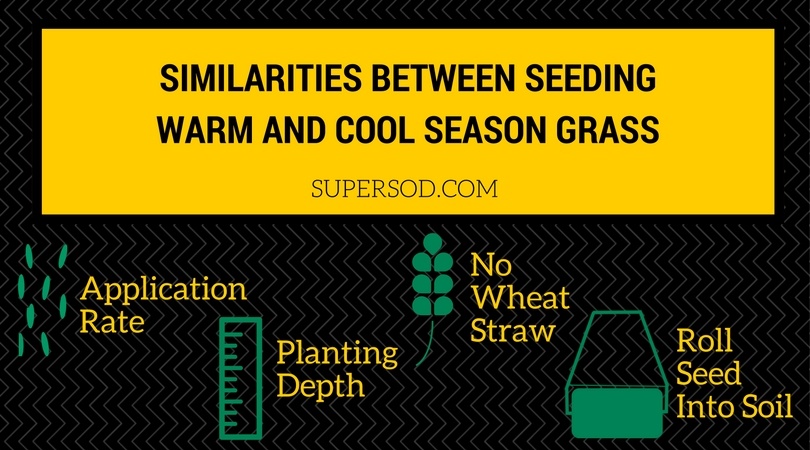

4 Similarities Between Seeding Warm-Season Grass and Cool-Season Grass

Maybe you’re experiencing the first growing season in your new home with a Fescue lawn. Or you could finally be switching over to a grass type that has a maintenance level more your speed. Whatever the case, you’re searching for the best way to improve your knowledge of your new lawn.
In a different place we gave you the 4 Differences between Warm- and Cool-Season Grass Seed. With those few nuances covered, today we’re discussing the similarities between the two.
Keep in mind, these similarities apply to seeding new TifBlair Centipede, Zenith Zoysia, and Elite Tall Fescue lawns. Fescue is the only type of grass in this group that requires overseeding.
1. Application Rate
When sowing warm season grass or cool season grass, keep in mind that there is such thing as sowing too much seed. Using more seed will not guarantee your lawn will fill out more quickly or that it will have a higher chance of dominating over weed seeds. Actually, spreading seeds in excess create a competition for resources between your seeds and result in a lack of nutrients.
Stick with the recommended distribution per square foot on the seed package label and follow the spreader setting recommendations. Selecting a spreader setting too large or too small can complicate your seeding process.
If you have more seed than you need, save the excess and use it for overseeding or filling in any bare spots during the next growing season. You may seal the bag in a Ziploc container and store it in the crisper drawer of your refrigerator. This type of storage will help prolong the life of your seed after you’ve opened the package.
2. Planting Depth
I remember “photosynthesis” as the most difficult spelling test word I had to learn in first grade. Though I prided myself on my superior spelling knowledge, the concept of photosynthesis was slightly more difficult to grasp — I didn’t catch on until second grade. The moral of this tangent is that the very elementary basics of photosynthesis tell us that plants need water, carbon dioxide, and sunlight to grow.
To ensure your seeds get enough precious sunlight, don’t plant them too deep. When topping the seeds with soil, add no more than .25 inch of compost. The soil that you’re sprinkling as lightly as fairy dust should ideally be compost such as Soil3 so your seeds are topped with pure nutrition.
Your seeds need sunlight to germinate properly. Using a compost roller (pictured) will ensure your layer of compost isn't too thick.
3. Wheat Straw
When seeding lawns, most folks automatically envision a layer of wheat straw over the seeds to prevent erosion. However, wheat straw will shade out the seeds and prevent germination. Instead, follow the directions above to spread a very thin layer of compost.
We also suggest using high-heat-processed compost instead of wheat straw not only for its soil amendment benefits, but for its lack of weed seeds. Wheat straw has the potential to introduce foreign weed seeds to your soil. These weeds can compete with your grass seedlings for resources, and you don’t want them to win. Start with compost, and you won’t be disappointed.
4. Rolling to Ensure Good Soil Contact
Once your seeds are in the ground and covered with the light dusting of compost, roll them to ensure good soil contact. Use a lawn roller that can be rented from your local hardware store. Fill the roller up with water until you are able to push it easily and without having to dig your feet into the ground.
Push the roller across the entire area that you’ve planted before beginning your intentional and calculated watering process for the best germination results.
Guarantee sufficient soil contact and a smooth lawn by using a lawn roller filled with water and rolling over your seed and compost.
Now that you’ve brushed up on the similarities, it’s time to put planting season on your calendar. See written steps and instructional videos for warm season grass options TifBlair Centipede and Zenith Zoysia. For Elite Tall Fescue check out directions for seeding a new Fescue lawn or overseeding an existing Fescue lawn.
Have any questions? That’s why we’re here! Comment below with all of your seeding questions.





![Patching Your Lawn with Warm Season Grass Seed [Video]](https://info.supersod.com/hs-fs/hubfs/Super-Sod%20BLOG/Imported_Blog_Media/bare%20dead%20spot%20in%20lawn.jpg?width=400&name=bare%20dead%20spot%20in%20lawn.jpg)